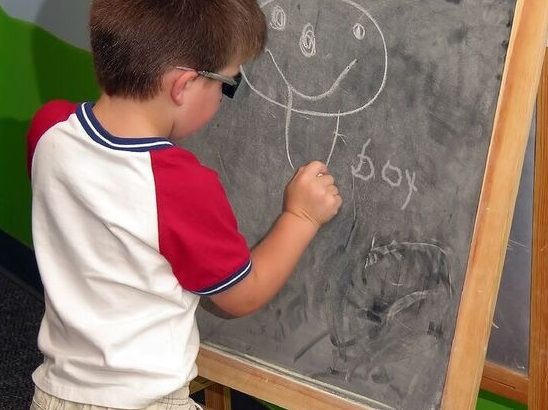Kinesthetic Recall
Kinesthetic learning relates to physical feelings such as a sense of body position, muscle movement and weight as felt through nerve endings. Many students who have trouble learning to spell are strong kinesthetic learners. They are easy to spot because they are usually accomplished on skateboards, bikes, skis, and anything involving motion such as dance and theater. These students may lag in a classroom because it is hard for any teacher, no matter how wonderful, to provide movement-based learning to 20+ students at one time in a classroom! And even if it were possible, all that motion would distract the students who need a quieter, calmer atmosphere. But there are techniques a classroom teacher, tutor, or parent can use to help a kinesthetic learner master spelling words.
Trace Over
Write the spelling word lightly so the student can trace over it. Use cursive if the student can handle it, because the swoopy feel of cursive is pleasurable for many kinesthetic learners. Find out if the student likes the feel of pencil, pen, fat marker, skinny marker, charcoal pencil, etc. It’s amazing how much longer a student practices if the feel of the writing instrument is pleasurable to them. We all have different nerve endings, so never assume that what feels best to you is right for the student. Tracing over allows the student to learn how it feels to write the word correctly. Since kinesthetic learners have great muscle memory, this aids in recalling the correct spelling of the word.
Air Writing
Use sticks, flags, scarves, or just a pointed finger to write the word large in the air. At first, stand behind the student and guide his or her hand to be sure practice is done correctly. Say the letters as you write them in the air. Let the student go outside or away from others to keep practicing. Move on to a new word only when the first one is mastered.
Sand Box
A cardboard box lid with a little bit of sand or dirt allows a student to practice spelling words using a forefinger as the writing instrument. This gives added tactile feedback from the rough sand, along with the motion of writing large in the box lid. If you can’t monitor the student directly, it’s best to provide the word(s) to copy to be sure practice is done correctly. Incorrect practice is worse than no practice at all!
Giant Writing in Color
Use a large whiteboard and markers of two or more colors. Have the student hold a marker at arm’s length and write the word as large as possible. Allow the student to use print or cursive as desired. If the student decorates or illustrates, that’s even better for recall. Have the student write over the original word in a new color. Have the student turn around while you erase a letter and then see if he or she can fill in the missing letter. Be sure to make this fun and game-like. It should not feel like a test.
Keyboarding
The same kinesthetic sense that produces a good skateboarder makes for an excellent typist. The key to success with this method is making sure students use the same motion for the same letter every time (touch typing) so that by learning to type a spelling word, they are also learning a series of muscle motions. In this way, their outstanding muscle memory will support their spelling, and even their reading!
Use a Mirror
Use a mirror so the student can watch his or her own mouth enunciating each syllable of the spelling word. Tying the syllables to the motion of the mouth will help with memory. Once the student has practiced with the mirror, then proceed to use one of the other techniques in this list to finish learning the word. Some students will also have fun practicing words by looking in the mirror to write instead of at their paper. This produces giggles which is a great thing to pair with spelling words.
Dance, Jump, Run
This works best outside. Write all 26 letters in sidewalk chalk scattered around a play area. The students can practice spelling words by dancing, jumping or running from one letter to the next in the right order. To assure correct practice it may be best to draw lines or have students check each other using a printed list. Groups of students can devise a dance in which each of them arrives at a letter one after another in the right order to spell a word.
Move to Learn
For many students, “sit down, be still, and be quiet” actually inhibits learning. For our kinesthetic students who need to move to learn, these seven techniques offer a chance to excel in spelling. Many dyslexic students are also kinesthetic learners, so these techniques are great ways to give your dyslexic students some fun help with a tough subject.
By Yvonna Graham, M.Ed.
www.dyslexiakit.net
@GrahamYvonna
